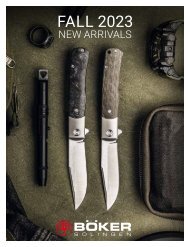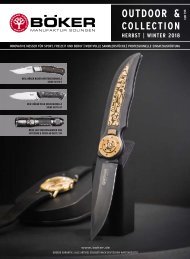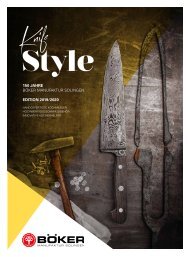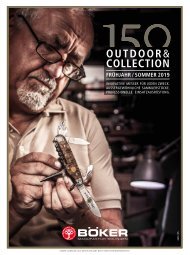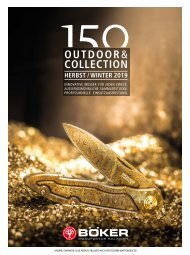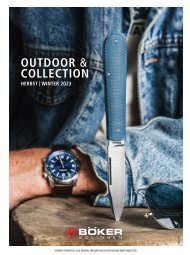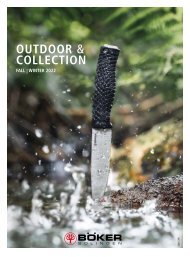Boker Knifestyle | EN Edition 2018 / 2019
Create successful ePaper yourself
Turn your PDF publications into a flip-book with our unique Google optimized e-Paper software.
12<br />
DAMASCUS<br />
Damascus steel – a millennia-old blacksmithing<br />
craft that still unfolds its<br />
fascination today. The first proof of<br />
Damascus is a Celtic sword from about<br />
500 BCE. Even though this forging<br />
technique most likely did not originate<br />
with the Celts, they did manage to perfect<br />
the process. The first artisan Damascus<br />
blades were made by the Teutons during<br />
the Great Migration Period (300 to 450<br />
CE). They were able to use controlled<br />
forging processes to make specific and,<br />
more importantly, repeatable Damascus<br />
patterns.<br />
Swords made from torsion Damascus<br />
were made with extremely sophisticated<br />
production methods, even by today’s<br />
standards. Artifacts like the sword from a<br />
grave near Sutton Hoo (England) posed an<br />
enormous challenge for today’s Damascus<br />
blacksmiths, until they figured out how to<br />
replicate this fascinating sword.<br />
At the time of the development in Europe,<br />
steel of excellent quality was also made<br />
in Japan, which was mainly used in the<br />
forged katana blades wielded by the<br />
samurai. For the longest time, history<br />
considered Japan to be the pioneer.<br />
Japanese swords were generally seen as<br />
superior to the European ones, although<br />
that is historically incorrect.<br />
Due to different cultural conditions, many<br />
more high quality Japanese than European<br />
swords have made it through the centuries<br />
unscathed. While Japanese swords were<br />
lovingly passed down from generation to<br />
generation, the artisan swords of Northern<br />
Europe were often sent to the grave with<br />
their owners and got lost in the mists of<br />
time.<br />
This led to an apparent “supremacy” of old<br />
Japanese swords in the present day, which<br />
cannot be matched by European artifacts<br />
in comparably flawless condition. Looking<br />
back, it can be said that forging multilayered<br />
steel was originally a means to<br />
achieve the best possible material quality.<br />
The decorative element of Damascus<br />
took much longer to come into its own.<br />
Today, Damascus steel is still very popular.<br />
However, this general enthusiasm is no<br />
longer rooted in technical consideration,<br />
but rather an expression of passion for<br />
the material and its special look that still<br />
radiates a near magical fascination. Today,<br />
there are several methods for making<br />
Damascus steel:







